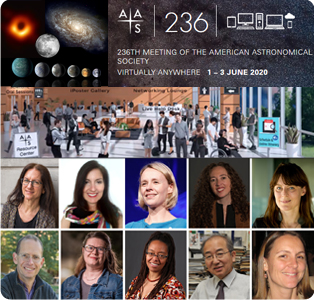India, China Increasingly Prioritize NewSpace / Commerce to Reach National Space Goals
|
MONDAY Highlights…
|

![]() = All times
= All times
for terrestrial events in local time unless noted.
![]() = All times for international terrestrial events in local time unless noted.
= All times for international terrestrial events in local time unless noted.
![]() = All times for space events, and…
= All times for space events, and…
![]() = All times for international space / astro events in Hawaii Standard Time unless noted. Add 10 hours to obtain UT (‘Universal Time’).
= All times for international space / astro events in Hawaii Standard Time unless noted. Add 10 hours to obtain UT (‘Universal Time’).
Weekly Planet Watch – Evening Planets: Mercury (WNW); Morning Planets: Mars (SE), Jupiter (SE), Saturn (SE), Neptune (ESE).
AAS 236 Hosts First Fully Virtual Meeting Including Exhibit, Plenary, Prize, Special and iPoster Sessions
American Astronomical Society is set to hold its 236th Meeting June 1-3, originally to be held in person at Madison WI, and now fully online to advance science while maintaining physical distance. Each day will run for ~10 hours and allow for online interactions during live oral and iPoster sessions, Q&A chats, exhibitor webinars and social lounges. There are about 700 participants listed. Major topics for consideration this year are black holes, exoplanets, galaxies, observatories / telescopes, dark matter, stars and interstellar medium. AAS President Megan Donahue will give welcome comments on Day 1, followed by Lisa Kaltenegger of Cornell University talking on ‘Searching for Habitable Worlds: Challenges, Opportunities & Adventures’. The Astronomy from the Moon Special Session, which could be a continuing series of events, will feature Jack Burns (Univ. of Colorado, Boulder), Linjie Chen (NAOC, CAS), Steve Durst (ILOA, Hawai’i) and possibly others. Day 2 will feature James Webb Telescope, Sofia, Hubble, a talk on mega-satellite constellations, and ‘Atacama Cosmology Telescope and the Simons Observatory: The Millimeter-Wave Sky from Chile’ by Jo Dunkley from Princeton Univ. On Day 3 Keck Observatory will host a Webinar title ‘A Public Goldmine of 26 Years of Observations’. There will also be Laboratory Astrophysics Division Meetings and a Solar Physics Division Prize Lecture. Two ‘Meetings-in-a-Meeting’ Sessions spanning all 3 days are Supermassive Black Hole Studies with the LSST, and The Interstellar Medium of Galaxies in the Era of Big Data. (Pictured: Plenary Speakers; Image Credits: AAS, Event Horizon Telescope, NASA) |
Continued From…
|
TUESDAY
![]() Jun 2 — Juno, Perijove 27 / 26th Science Flyby, Jupiter Orbit: NASA craft in 53-day orbit to come within ~3,500 km of Jupiter cloud tops during Perijove 27, its 27th close flyby of Jupiter and 26th science flyby with instruments turned on, 10:19:55.
Jun 2 — Juno, Perijove 27 / 26th Science Flyby, Jupiter Orbit: NASA craft in 53-day orbit to come within ~3,500 km of Jupiter cloud tops during Perijove 27, its 27th close flyby of Jupiter and 26th science flyby with instruments turned on, 10:19:55.
![]() Jun 2 — Kavli Institute for Particle Astrophysics and Cosmology (KIPAC), Stanford CA / Online: Public Lecture: Pictures of Distant Worlds; by Prof. Bruce Macintosh, 18:00.
Jun 2 — Kavli Institute for Particle Astrophysics and Cosmology (KIPAC), Stanford CA / Online: Public Lecture: Pictures of Distant Worlds; by Prof. Bruce Macintosh, 18:00.
![]() Jun 2-4 — International Academy of Astronautics, American Astronautical Society, RUDN University, Moscow, Russia: 3rd IAA/AAS Scitech Forum; conference TBD.
Jun 2-4 — International Academy of Astronautics, American Astronautical Society, RUDN University, Moscow, Russia: 3rd IAA/AAS Scitech Forum; conference TBD.
![]() Jun 2-5 — European Organization for Nuclear Research (Cern), German Electron Synchrotron (DESY), Online / Hamburg, Germany: Online: 7th Dark Matter @ LHC 2020 Workshop.
Jun 2-5 — European Organization for Nuclear Research (Cern), German Electron Synchrotron (DESY), Online / Hamburg, Germany: Online: 7th Dark Matter @ LHC 2020 Workshop.
![]() Jun 2 — Moon: at perigee (distance 364,384 km), 17:35.
Jun 2 — Moon: at perigee (distance 364,384 km), 17:35.
![]() Jun 2 — Apollo Asteroid 2020 KJ1: Near-Earth Flyby (0.014 AU)
Jun 2 — Apollo Asteroid 2020 KJ1: Near-Earth Flyby (0.014 AU)
![]() Jun 2 — Apollo Asteroid 2020 KN2: Near-Earth Flyby (0.015 AU)
Jun 2 — Apollo Asteroid 2020 KN2: Near-Earth Flyby (0.015 AU)
![]() Jun 2 — Apollo Asteroid 2020 KE4: Near-Earth Flyby (0.027 AU)
Jun 2 — Apollo Asteroid 2020 KE4: Near-Earth Flyby (0.027 AU)
![]() Jun 2 — Apollo Asteroid 2020 KE4: Near-Earth Flyby (0.031 AU)
Jun 2 — Apollo Asteroid 2020 KE4: Near-Earth Flyby (0.031 AU)
WEDNESDAY
![]() Jun 3 — ESA, Online: Liive streamed conversation with European experts on how space can help with post-millennials’ education and social lives.
Jun 3 — ESA, Online: Liive streamed conversation with European experts on how space can help with post-millennials’ education and social lives.
![]() Jun 3 — Venus: at inferior conjunction with the Sun, 0.289 AU from Earth, 08:00.
Jun 3 — Venus: at inferior conjunction with the Sun, 0.289 AU from Earth, 08:00.
![]() Jun 3 — Apollo Asteroid 2020 KE4: Near-Earth Flyby (0.020 AU)
Jun 3 — Apollo Asteroid 2020 KE4: Near-Earth Flyby (0.020 AU)
THURSDAY
![]() Jun 4-5 — National Academies, Online / Washington DC: Virtual Meeting: Workshop on Earth System Predictability Research and Development.
Jun 4-5 — National Academies, Online / Washington DC: Virtual Meeting: Workshop on Earth System Predictability Research and Development.
![]() Jun 4 — Mercury: at easternmost elongation, 03:00.
Jun 4 — Mercury: at easternmost elongation, 03:00.
![]() Jun 4 — Apollo Asteroid 2020 KN5: Near-Earth Flyby (0.041 AU)
Jun 4 — Apollo Asteroid 2020 KN5: Near-Earth Flyby (0.041 AU)
FRIDAY
![]() Jun 5 — Heritage Auctions, Dallas TX: Space Exploration Auction Opens: Apollo 17 Flown MS68 NGC Silver Robbins Medallion, Serial Number 159, originally from the personal collection of Mission Commander Gene Cernan.
Jun 5 — Heritage Auctions, Dallas TX: Space Exploration Auction Opens: Apollo 17 Flown MS68 NGC Silver Robbins Medallion, Serial Number 159, originally from the personal collection of Mission Commander Gene Cernan.
![]() Jun 5-7 — Royal Astronomical Society of Canada (RASC), Vancouver, British Columbia, Canada: 2020 RASC General Assembly; cancelled.
Jun 5-7 — Royal Astronomical Society of Canada (RASC), Vancouver, British Columbia, Canada: 2020 RASC General Assembly; cancelled.
![]() Jun 5-7 — Scientific Coalition for UAP Studies, Huntsville AL: Anomalous Aerospace Anomalies; at Rocket City Conference Center; postponed to 2021.
Jun 5-7 — Scientific Coalition for UAP Studies, Huntsville AL: Anomalous Aerospace Anomalies; at Rocket City Conference Center; postponed to 2021.
![]() Jun 5-7 — Group on Earth Observations (GEO), Online / Geneva, Switzerland: Virtual: GEO Indigenous COVID-19 Hackathon 2020.
Jun 5-7 — Group on Earth Observations (GEO), Online / Geneva, Switzerland: Virtual: GEO Indigenous COVID-19 Hackathon 2020.
![]() Jun 5 — Moon: 6.3° NNE of Antares, 02:00; Full Strawberry Moon, 09:12.
Jun 5 — Moon: 6.3° NNE of Antares, 02:00; Full Strawberry Moon, 09:12.
![]() Jun 5 — Penumbral eclipse of the Moon: Visible in Europe, Asia, Australia, Africa, South/East South America, Pacific, Atlantic, Indian Ocean, Antarctica; stars 07:45:55, maximum 09:24:55, ends 11:04:03.
Jun 5 — Penumbral eclipse of the Moon: Visible in Europe, Asia, Australia, Africa, South/East South America, Pacific, Atlantic, Indian Ocean, Antarctica; stars 07:45:55, maximum 09:24:55, ends 11:04:03.
![]() Jun 5 — Apollo Asteroid 2020 KA6: Near-Earth Flyby (0.030 AU)
Jun 5 — Apollo Asteroid 2020 KA6: Near-Earth Flyby (0.030 AU)
SATURDAY
![]() Jun 6-7 — British Interplanetary Society, London, United Kingdom: 40th Sino-Russian Technical Forum; postponed.
Jun 6-7 — British Interplanetary Society, London, United Kingdom: 40th Sino-Russian Technical Forum; postponed.
![]() Jun 6 — Daytime Arietid meteors: Peak 11:00, meteor shower offers up to 30 per hour.
Jun 6 — Daytime Arietid meteors: Peak 11:00, meteor shower offers up to 30 per hour.
![]() Jun 6 — Aten Asteroid 163348 (2002 NN4): Near-Earth Flyby (0.034 AU)
Jun 6 — Aten Asteroid 163348 (2002 NN4): Near-Earth Flyby (0.034 AU)
![]() Jun 6 — Apollo Asteroid 2020 KQ1: Near-Earth Flyby (0.034 AU)
Jun 6 — Apollo Asteroid 2020 KQ1: Near-Earth Flyby (0.034 AU)
![]() Jun 6 — Amor Asteroid 2020 KO1: Near-Earth Flyby (0.040 AU)
Jun 6 — Amor Asteroid 2020 KO1: Near-Earth Flyby (0.040 AU)
SUNDAY
![]() Jun 7 — Parker Solar Probe, Heliocentric Orbit: Spacecraft reaches 5th perihelion today.
Jun 7 — Parker Solar Probe, Heliocentric Orbit: Spacecraft reaches 5th perihelion today.
![]() Jun 7 — Apollo Asteroid 2020 KK3: Near-Earth Flyby (0.045 AU)
Jun 7 — Apollo Asteroid 2020 KK3: Near-Earth Flyby (0.045 AU)
![]() Jun 7 — Apollo Asteroid 471926 Jormungandr: Near-Earth Flyby (0.045 AU)
Jun 7 — Apollo Asteroid 471926 Jormungandr: Near-Earth Flyby (0.045 AU)

